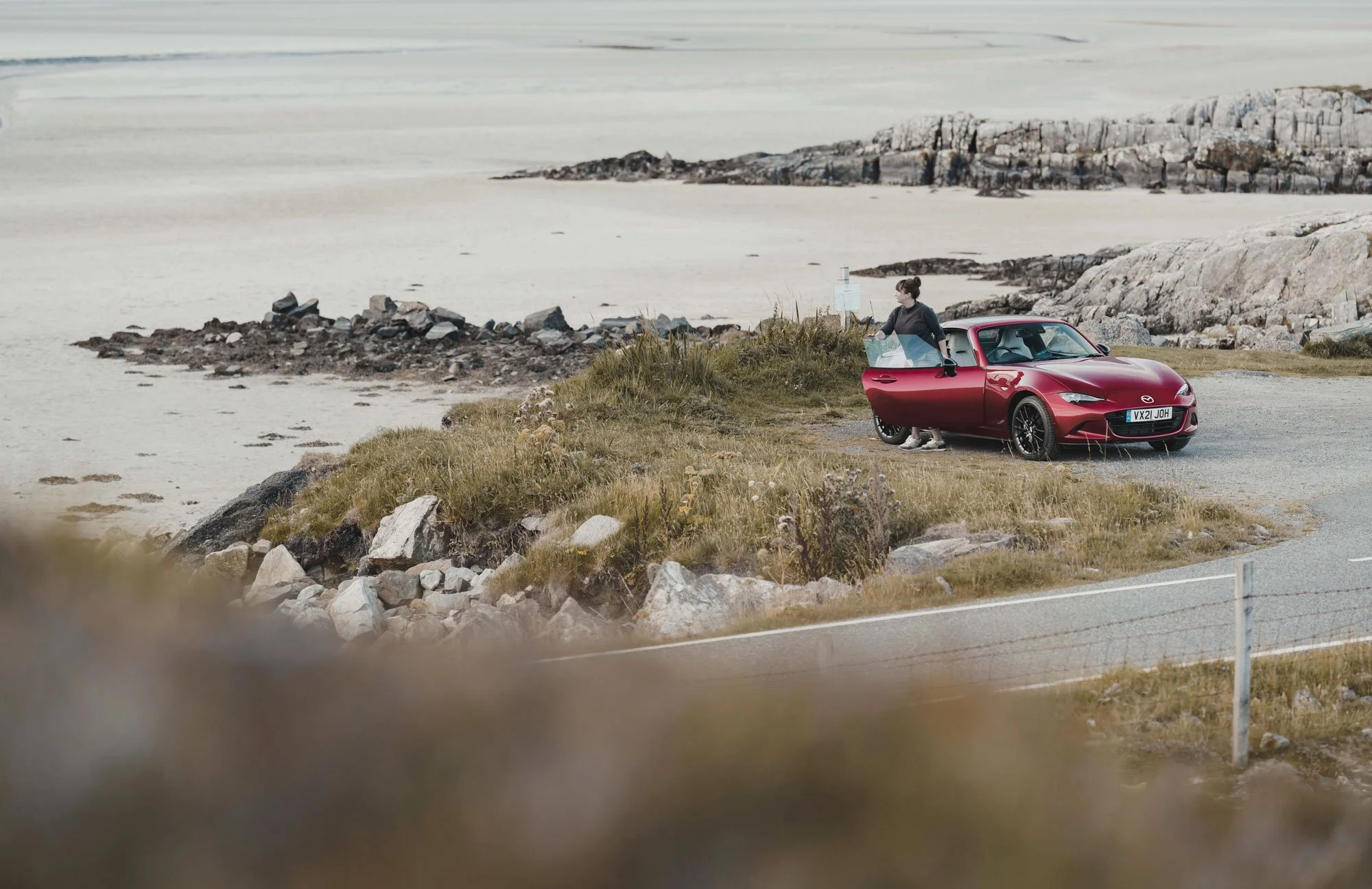MAZDA STORIES
Outer space
Paddleboarding in the seclusion of Scotland’s Outer Hebrides with the Mazda MX-5 Miata RF. The perfect blend of power, performance and practicality.
A fog-veiled ferry voyage from Scotland’s far north west coast, the Outer Hebrides are a byword for remote. Despite their lonely Atlantic location they are suprisingly clement, home to acres of immaculate white sand beaches and empty sweeping roads. I’m heading for Lewis and Harris to find the perfect spot to test drive my inflatable paddleboard and open up the latest RF MX-5 along the way.
Although they are part of the same land mass Lewis and Harris are distinct regions covering the north and south parts of the island respectively – the largest of the Outer Hebridean archipelago. On disembarking the ferry onto the stoney grey streets of Stornaway I head south towards Harris’s famed Luskentyre Beach.
It is unthinkable to keep the roof down here and I stop for a few seconds to retract the hard top. Half the joy of this kind of car is in immersing your senses in the environment. As I leave town I absorb the brackish peat scents and rowdy seagull choir. My local folk soundtrack is punctuated by cattle-grid drum rolls but the Bose Audiopilot compensates for wind and road noise allowing me to keep hands on the wheel rather than fiddling with the volume.
As the roads converge into a winding single track, I begin to find my rhythm, arcing round a maze of shallow inlets and ancient gneiss – the Hebrides are home to some of the oldest rocks in Europe. I soon learn to synchronise with the local drivers, swooping in and out of passing nooks, confident in the MX-5's precision. Blithe Highland cows and graffitied rams meander into my path and I maneuvre gently out of their way.
The sun is playing hard to get, peering coyly between the clouds but just as I arrive at Luskentyre it breaks through and the whole landscape comes alive. The beach is everything I was promised, wild, dramatic and for the most part empty. A retreating tide reveals immense seaweed-draped stretches of crisp white sand but it’s too far to carry the paddleboard, inflatable or otherwise. After a brisk walk around the bay I’m ready for some of Harris’ much lauded seafood.
The very last thing you expect to find in one of the furthest corners of the Hebrides is a queue of people. But in the secluded lunar wilds of Harris there sits Sam's Seafood Shack, a charming green wooden kitchen where local chef Sam Barnes prepares whatever seafood has been caught locally that day to serve a loyal line of hungry locals and tourists – some who’ve driven hours to sample the sweet local scallops and smoked mussels with seaweed on offer. Sam’s not the only resident to make the most of the abundant algae found in the Hebrides. Sugar kelp is sustainably harvested by local diver and seaweed expert Lewis MacKenzie for the Isle of Harris Distillery’s gin.
There is no time to stop at the distillery though, I’m eager to get out onto the water and there are still lots of options to explore. In the queue at Sam’s one local I spoke to suggested Hushinish Beach, the very name suggests a secret to be discovered. I do just have time for a flying detour across the Scalpay Bridge just east of Tarbet on the way. Connecting the tiny but industrious island of Scalpay to Harris the bridge is a striking modern addition to the mostly traditional architecture on the island. Through intelligent engineering the bridge’s design addresses complex geology and the need to withstand high winds and ferocious winters. The glorious view merits a couple of laps of the elegant structure but then it really is time to get back on track.
Hushinish is just over an hour north on the map unless you count slowing down for every ‘Caution Otter Crossing’ sign and poorly parked tourist so it takes me nearly two. Hushinish is another stunning example of the island’s almost tropical looking beaches but the wind is whipping up distinctly non-paddleboard friendly waves by the time I arrive. I realise I need somewhere a little more sheltered so with only a few hours of daylight remaining I hop onto the A859, the main road north with my fingers crossed for my final destination.
The landscape flattens out a little as I pass into Lewis but it’s still a gentle rollercoaster of dips and machair covered curves. In just under two hours I reach Lewis’s northernmost parish, the Port of Ness. I park on the historic stone jetty which drops directly into what could easily pass for Mediterranean turquoise water. I'm trying out the SIPA board, an innovative self-inflating SUP which uses the same motor to power the board which greatly extends its range. It also helps keep paddleboarders safe if they get stuck in a current. The board is stowed neatly in a backpack in the boot along with collapsible paddles, wetsuit and a thermos flask full of hot chocolate.
A steep slipway provides the perfect entry point and I’m soon away into the blue. The sinking sun gilds the water and casts the distant bay in silhouette. I marvel at the water’s clarity then curse it as a cluster of jellyfish appear providing all the motivation I need to stay upright on the board. Between the sunshine haze and vivid hue of the sea it’s hard to believe I’m in Scotland. Until that is, I’m back on land. I become extremely grateful for the retractable fastback roof when legion midges descend. Sinking into my heated seat I deploy the roof as a shield against the maddening clouds of insects and watch the sun dissolve into the bay
Direction + words: Jenni Doggett
Photography: Jack Harding
Film: Calum Currie





